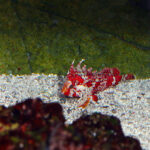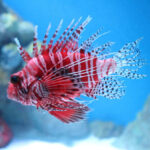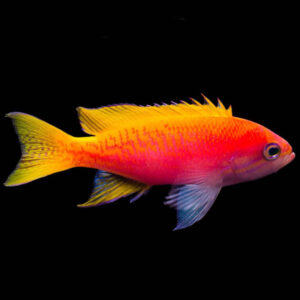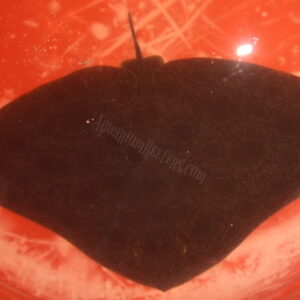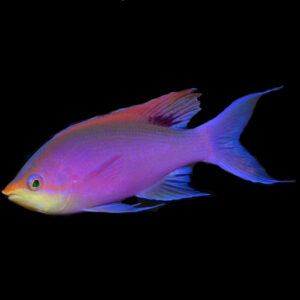Description
The Female Blue Throat Trigger, scientifically known as Xanthichthys auromarginatus, is a stunning fish species with distinct physical characteristics. It can reach a maximum size of around 12 inches (30 centimetres) in length. they are decorated by blue dots.
The body of the Female Blue Throat Trigger is laterally compressed and framed by triangular shaped fins, which undulate as the fish swims. The unusual motion is mesmerising to watch.
Taxonomy
The Blue Throat Trigger, sometimes called Glided Trigger, belongs to the genus Xanthichthys and the family Balistidae, commonly known as triggerfish. This family comprises various species of marine fishes characterized by their unique fin structures and strong, robust bodies. The Blue Throat Trigger is closely related to other members of the Xanthichthys genus, such as Xanthichthys caeruleolineatus and Xanthichthys mento. The genus name “Xanthichthys” is derived from the Greek words “xanthos” meaning “yellow” and “ichthys” meaning “fish,” referring to the yellowish colour often seen in these fish.
Natural Habitat
The Female Blue Throat Trigger inhabits coral reefs and rocky areas in its natural habitat. It seeks shelter among the reef structures, including crevices, caves, and coral heads. The reef environment provides the fish with abundant hiding spots and potential food sources. These triggers can be found in tropical marine waters, where the temperature ranges from 75-82°F (24-28°C).
Keeping Female Blue Throat Trigger Healthy:
Keeping the Blue Throat Trigger healthy requires careful attention to its specific care needs. The care level for this fish is moderate, and it may present some challenges. Maintaining a suitable aquarium environment is crucial, including a tank size of at least 100 gallons (380 litres) to provide ample swimming space. The water temperature should be maintained between 75-82°F (24-28°C), with a pH level of 8.1-8.4.
Special Requirements and Feeding
The Female Blue Throat Trigger has special dietary requirements and should be provided with a varied diet. They are omnivorous, feeding on a combination of meaty foods and vegetable matter. Their diet should include a mix of high-quality pellets, frozen or live foods such as shrimp, squid, and marine algae or seaweed. Offering a balanced diet and feeding multiple times a day will help ensure their nutritional needs are met.
How Many Should I Keep?
It is recommended to keep only one Blue Throat Trigger, or a established pair, per tank, due to their territorial nature. They may exhibit aggression towards conspecifics and other similarly shaped fish. Providing ample hiding spots and maintaining suitable space in the aquarium can help mitigate territorial disputes.
Lighting Preference
The Blue Throat Trigger does not have specific lighting preferences. However, providing a well-lit aquarium with a mixture of ambient and direct lighting can enhance the visual appeal of the fish and the overall aesthetics of the tank.
Suitable Tank Mates
When choosing tank mates for the Female Blue Throat Trigger, it is important to consider their territorial behaviour and potential aggression. It is recommended to select tank mates that are larger and more robust, such as tangs, larger wrasses, ect. Avoid keeping them with smaller, more timid fish that may become targets of aggression.
Reproduction in the Wild
In the wild, the Blue Throat Trigger (Xanthichthys auromarginatus) follows a fascinating reproductive process. During courtship, the male performs a distinctive “wiggle dance” to attract the female. This dance involves shaking its body rapidly and displaying its vibrant colours. The male may also make clicking sounds to communicate with the female and establish their bond.
Breeding Xanthichthys auromarginatus:
- Set up:
Breeding Blue Throat Triggers in captivity requires a spacious aquarium with appropriate hiding spots, such as caves or PVC pipes, to simulate their natural habitat. The tank should be well-maintained with stable water parameters.
- Courtship/Spawning:
To initiate courtship, introduce a compatible pair into the breeding tank. The male will exhibit courtship behaviours, including the aforementioned wiggle dance, to entice the female. Once courtship is successful, the female will release her eggs, and the male will fertilize them externally. The eggs are adhesive and will attach to a surface within the tank.
- Rearing:
After spawning, it is crucial to promptly remove the adult fish from the breeding tank to prevent them from consuming the eggs. The fertilized eggs will hatch into larvae within a few days. Provide appropriate food for the larvae, such as zooplankton or specially formulated larval foods. As they grow, gradually introduce larger food items and monitor their development closely.
Sexual Dimorphism
Sexual dimorphism in Blue Throat Triggers is prominent. Males have a blue chin and yellow in their fins. Females are more brown in colour.
Distribution
The Female Blue Throat Trigger, Xanthichthys auromarginatus, is naturally distributed throughout the Indo-Pacific region. It can be found in various locations, including the Red Sea, eastern coast of Africa, Indian Ocean, and parts of the Pacific Ocean. The original fish, whether wild-caught or captive-bred, typically originates from these regions.
Summary
The Blue Throat Trigger, scientifically known as Xanthichthys auromarginatus, is a striking fish species renowned for its vibrant blue throat patch and beautiful colouration. It requires a moderate level of care and attention to thrive in captivity. Breeding this species involves creating a suitable breeding setup, observing courtship behaviours, and providing proper rearing conditions for the hatched larvae. While sexual dimorphism is not evident, the fish’s natural distribution spans the Indo-Pacific region. It is important to note that Blue Throat Triggers are a bit on the delicate side in terms of care and require specific attention to their needs to ensure their well-being.
The Fish pictured here are representative only and the livestock you receive may vary in pattern, coloration, and shape.

